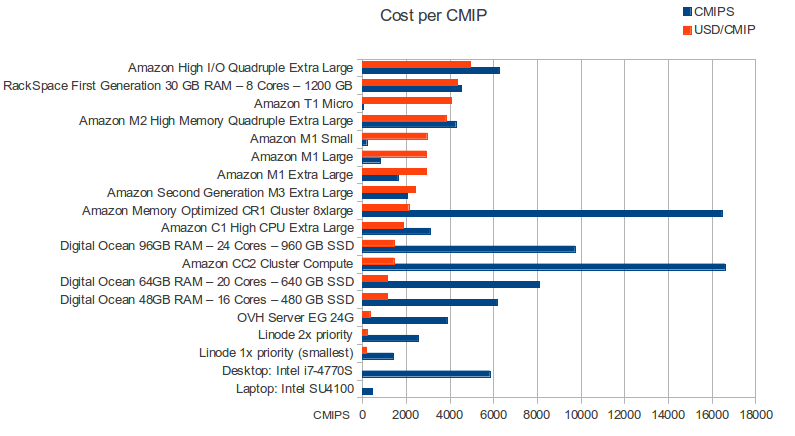CUP – Cost of Unit Process, CUP is the cost in USD to get 1 CMIP for a given instance.
CUP is get by diving cost of the instance per-hour-running by the number of CMIPS that the instance achieved in the tests.
So we get the next table, sorted from cheapest to expensive:
| Instance name | CMIPS | Price/CMIP |
|---|---|---|
| Linode 1x priority (smallest) | 1427 | 0.0000194658568870202 |
| Linode 2x priority | 2556 | 0.000021735350373848 |
| OVH Server EG 24G | 3881 | 0.000035429 |
| Digital Ocean 48GB RAM – 16 Cores – 480 GB SSD | 6172 | 0.0001142255 |
| Digital Ocean 64GB RAM – 20 Cores – 640 GB SSD | 8116 | 0.0001159438 |
| Amazon CC2 Cluster Compute | 16608 | 0.0001445087 |
| Digital Ocean 96GB RAM – 24 Cores – 960 GB SSD | 9733 | 0.0001449707 |
| Amazon C1 High CPU Extra Large | 3101 | 0.0001870364 |
| Amazon Memory Optimized CR1 Cluster 8xlarge | 16468 | 0.0002125334 |
| Amazon Second Generation M3 Extra Large | 2065 | 0,0002421308 |
| Amazon M1 Extra Large | 1635 | 0.000293578 |
| Amazon M1 Large | 817 | 0.0002937576 |
| Amazon M1 Small | 203 | 0.0002955665 |
| Amazon M2 High Memory Quadruple Extra Large | 4281 | 0.0003830881 |
| Amazon T1 Micro | 49 | 0.0004081633 |
| RackSpace First Generation 30 GB RAM – 8 Cores – 1200 GB | 4539 | 0.0004362194 |
| Amazon High I/O Quadruple Extra Large | 6263 | 0.0004949705 |
And the graphic, sorted from expensive to cheap.
Orange bars reflect CUP (multiplied by 10M to fit well in the graph), and blue bars show MIPS achieved by the instance.
Desktop: Intel i7-4770S and Laptop: Intel SU4100 have no CUP associated as are included in the graph only to compare CPU performance.
So, having also all the other parameters in mind (bandwidth per instance, cost per exceeded Gigabyte, storage, speed of the storage, time to launch a new instance, if provisioning is paid by hour, by day or by month, etc…) most Startups that use webservers and the Cloud to scale up Arrays of instances to deal with peaks at highly traffic hours, and scale down the number of instances at valley hours or when number or users/traffic decreases, will consider using the instances with lower CUP, or find a balance between instance with enough performance and low Cost of Unit Process.

Pingback: The Cloud is for Scaling | Carles Mateo